It is September 13, 2015, Day 28 of the Dyett Hunger Strike. Parents are physically starving and the children are hungry for a quality education. The Hunger Strike Continues!
Update; Day 30 Two Dyett Protesters Stop Hunger Strike as Health Dangers Escalate
The words of James Weldon Johnson’s “Lift Every Voice and Sing” echoed down Drexel Ave on Chicago’s South Side the mild summer evening of September 8, 2015. Down the street from the Chicago home of President Obama, the Dyett hunger strikers and their supporters, holding candles in the deepening darkness, shared this song that is often called the Black National Anthem:
“Lift every voice and sing
Till earth and heaven ring
Ring with the harmonies of Liberty;
let our rejoicing rise,
high as the listening skies, let it resound loud as the rolling sea
sing a song full of faith that the dark past has taught us,
sing a song full of the hope that the present has brought us;
facing the rising sun of our new day begun,
Let us march on till victory is won. ”
It was an opportunity for the hunger strikers and their supporters to reflect on the centuries-old African American struggle for freedom and their role in the struggle—Day 23 of the hunger strike to create the Walter Dyett High School for Global Leadership and Green Technology at the now closed Dyett High School building in Chicago’s Washington Park.
The hunger strike is now at Day 28 as of this writing and the Chicago Board of Education has finally opened talks with the strikers. There is a cautious optimism that perhaps the Dyett struggle, which in one form or another has been going on for at least 6 years, will reach a milestone in its journey toward education justice.
When Dyett was closed earlier in 2015, there were no more open enrollment neighborhood high schools left in the South Side Bronzeville neighborhood it once served.
The hunger strikers have been willing to put their lives on the line for quality education, an African American tradition that goes back to slavery times.
'Even when we were in slavery black people fought for schools. And our ancestors evacuated the South to come here, to find a better life for their children…. The institution that our ancestors fought for and won—we’ve got to reclaim it.'
~ Jitu Brown a Hunger Striker and member of the Kenwood Oakland Community Organization (KOCO) and the Coalition to Revitalize Dyett.
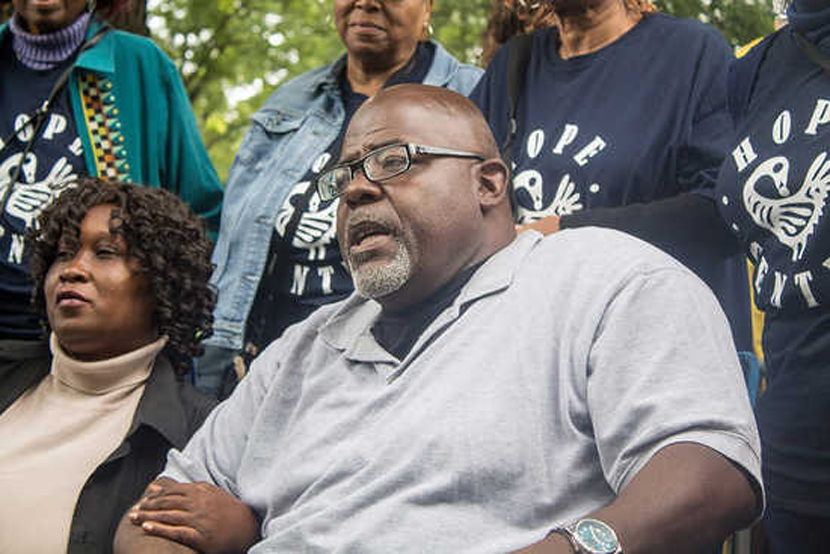
Jitu Brown with hunger striker Irene Robinson(left)
KOCO plays a key role in the Coalition to Revitalize Dyett (which I will refer as the Coalition for the rest of this article), the organization that is out to transform the now closed Dyett High School into a 21st century freedom school. These are their demands for reopening the school:
- Green Technology in school name and in school curriculum.
- Global leadership/ world studies curriculum
- Duane Turner as the school principal, who was selected by Coalition to Revitalize Dyett
- Fully elected local school council in year 1.
- Coalition to Revitalize Dyett represented on design/planning team with 6 members in prominent positions. Those who paid protesters to support closing Dyett cannot be on planning team.
- The school must retain the name Walter H. Dyett.
- Vertical curricular alignment with the 6 feeder schools identified in the Coalition proposal.
- Community school (open till 8pm daily, with programs and resources for parents, students and the community)
The proposal envisions a rich full curriculum of the humanities, the arts, math, music, world languages, science and physical education as well as green technology and the development of leadership skills. The governance of the school would be based upon a participatory model that includes parents, teachers, students and staff. There would be close collaboration with the community at large.
As Coalition member Pauline Lipman said at a speak-out supporting the hunger strikers, the proposal could serve as a model for working class education throughout the city.
“School Closings are a Hate Crime.” ~Irene Robinson, Dyett hunger striker.
Years before being closed at the end of the 2014-15 school year, Dyett had been a highly regarded neighborhood middle school where parents from around the city also sent their children. Dyett is located in Bronzeville, a historically African American neighborhood that has become contested terrain because of its location between the glittering towers of downtown Chicago and affluent Hyde Park where the University of Chicago is located.
Gentrification efforts were stepped up in Bronzeville in the late 1990s and resulted in a wave of Bronzeville elementary school closings. Bronzeville became a living laboratory for the city elite on how to do school closings, resulting in the infamous 50 school closings of 2013. Most of those affected have been Black and Brown students.
'I live in a city where the only mistake of me and my children is being black. I live in a city where the mayor and alderman don’t respect working families, no matter which way you try to say it.'
~ Hunger Striker Jeanette Taylor Ramann
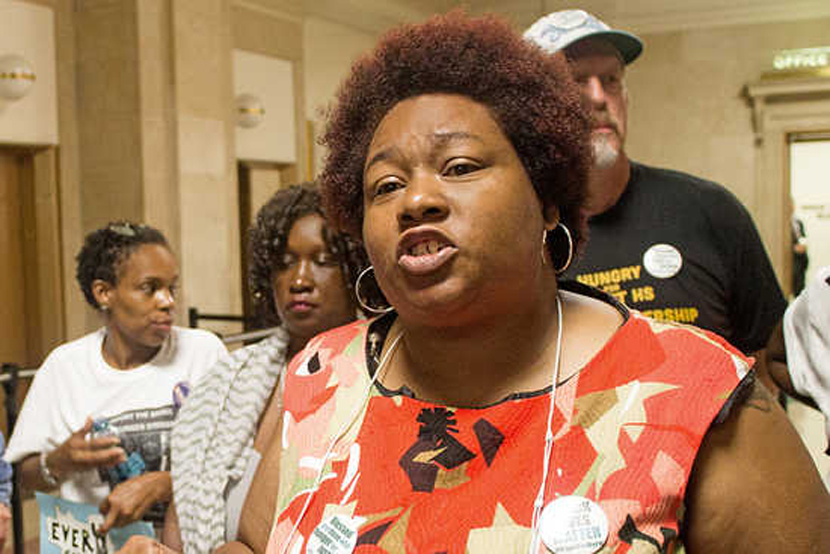
Jeanette Taylor-Ramann
According Jitu Brown, the problems for Dyett began in 1999 when against the wishes of its local school council, it was changed to a high school, but without the necessary resources. Dyett was to be starved into destruction. In 2011 CPS announced that Dyett would phased out.The last handful of students were reduced to taking courses like art and PE online.
The practice of starving neighborhood schools in Black and Brown working class neighborhoods, labeling them “failing” and then opening up charter, contract and turnaround schools to replace them is part of an overall privatization drive closely linked to a general disinvestment in local businesses and social services necessary for strong and positive social relations.
'We’re not just seeing school closings here, we’ve seen the closings of hospitals and trauma centers, the elimination of grocery stores and more. We’re looking at a systematic disinvestment in our families, our youth, our elders, our communities.'
~ Dyett Hunger Striker Jitu Brown
School closings are designed to destabilize working class communities. Neighborhood schools are part of a complex set of intergenerational human relationships that help hold communities together that under siege from outside forces. As people leave the neighborhood in desperation, this opens the way for profitable city-subsidized redevelopment schemes that push out remaining working class residents (mostly people of color) in favor of mostly white affluent newcomers.
School closings are part of the general disinvestment that fuels violence and social alienation, especially among young people. In an interview with hunger striker Irene Robinson she said this to me:
'Children naturally want to love. But this society has inflicted so much hate on Black and Brown communities that the violence you see stems from that. It’s manufactured… Dyett was our school. It had been there for 30 years. There was so much love and memories there. They didn’t just close a school, the closed the doors on the future of our children. They killed so much memory .They can never pay us back for what they have done to our children.'
~ Dyett Hunger Striker Irene Robinson
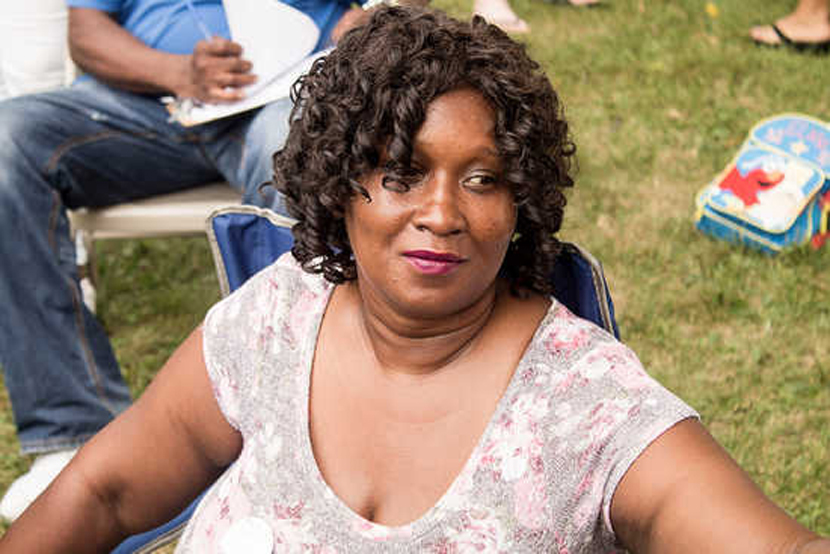
Irene Robinson
It is class and ethnic cleansing by economic means— but communities do not go down without a fight. Led by KOCO, community residents came up with a plan to save Dyett. Eve L. Ewing a Harvard PhD student writing her thesis on South Side Chicago school closings, focusing particularly on Bronzeville explains:
'After CPS’s plan to close Dyett was announced four years ago (2011), a coalition of community members led by KOCO created a proposal for it to reopen as what they have called a 'global village academy,' an open-enrollment neighborhood high school where teachers, parents, and local school council members would work together with educators from the local elementary schools to share resources to create a continuous educational pipeline for students from preschool to twelfth grade. The district ignored the idea.''
But facing more protest, the Board of Education finally agreed to solicit ideas for how to save Dyett, the last open enrollment neighborhood high school in Bronzeville. The Coalition to Save Dyett in close consultation with parents and community members wrote an ambitious proposal for a global leadership-green technology high school with partners that included the Chicago Botanic Garden, the University of Illinois and the Chicago Teachers Union. There were proposals from two other groups, neither of which were very inspiring.
The Board promised an answer in August 2015. When they postponed their decision until September, after the start of the school year, the Coalition concluded the fix was in. Drastic action was needed. The hunger strike began with the strikers sitting outside of the Dyett building in a small circle of folding chairs, meeting the media, consulting with their supporters and organizing actions like the non-violent disruption of a Mayoral town hall budget meeting which saw Mayor Emanuel flee out the back door. The strikers have received help from a variety of organizations including the Chicago Teachers Union.
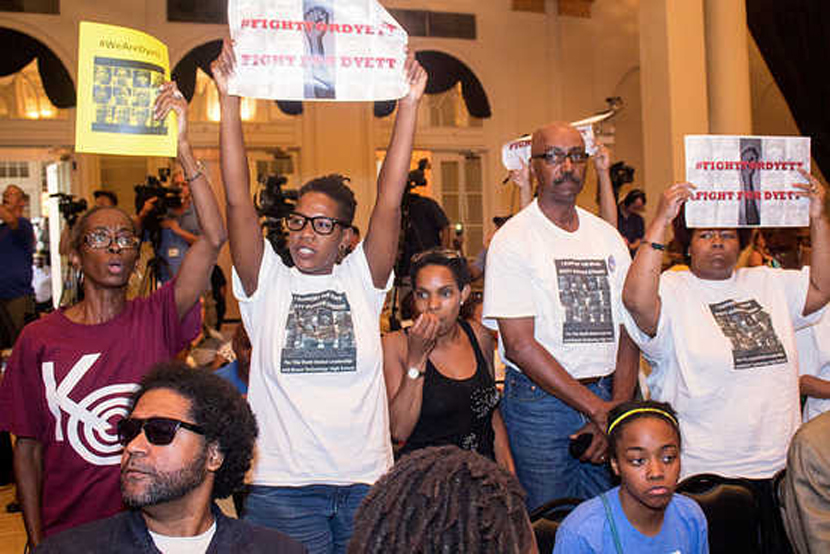
The hunger strikers lead a protest at a Mayoral town hall
On September 3rd when CPS announced that Dyett would be reopened as an “art and technology” high school, the strikers were not impressed. This so-called “compromise” was engineered with the help of South Side politicians close to the Mayor. It was a patched together public relations scheme with no community involvement; just another hasty back-room deal Chicago-style. The Coalition was not consulted and told flatly by Chicago school chief Forest Claypool that there would be no negotiations. The group was even locked out of the press conference announcing the “compromise”.
This was not what the community had been fighting for. The strike continued. The strikers went on with their protests, rallies and news conferences. Some of the hunger strikers flew to Washington DC to meet with Education Secretary Arne Duncan. They are thinking about taking their case to the United Nations after Chileans who battled school closings in their country told them of the success they had when the UN became involved. The battle had gone international.
Then on the September 11, the hunger strikers got a call from the Chicago Board of Education saying it was finally ready to talk. The results of the meeting were inconclusive, but the hunger strikers expressed cautious optimism to their supporters at a meeting held that evening at Operation PUSH.
But What is it About the Dyett High School Proposal that is so Abhorrent to the Mayor and the City Elite?
'Our model is of a sustainable school deeply rooted in the community. This proposal comes from the people of Bronzeville who speak from the heart about a school that lives in a village of tightly interconnected feeder schools, community institutions, local school councils of dedicated and loving adults, relationships, and the meaning of place… This is a model that nurtures leadership, it teaches perseverance, expects the best and supports solidarity. It is a model based on a broad notion of success for the students, their families, neighborhood, city, country and world.”
~ excerpt from the proposal submitted by the Coalition to Revitalize Dyett
This vision of education runs completely counter to the corporate-driven model favored by the Mayor: with its rigid top-down curricula; its brutal regimen of high stakes testing; its racist allocation of resources; its sneering contempt for Black and Brown people and its privatization of public education. The Mayor’s vision rips communities apart and divides them. It is designed to blunt the intellect and shrink the imaginations of Black and Brown working class youth so they will submit to the demands of austerity capitalism.
As hunger striker Irene Robinson put it, “They starve our schools. They hurt our children. And they don’t care if we die.”
One afternoon before we marched to President Obama’s home for the candlelight vigil, I sat down for a conversation with Rico Gutstein. Gutstein, a University of Illinois education professor, helped design and coordinate the writing of the proposal for the Walter Dyett High School for Global Leadership and Green Technology. Gutstein emphasized that the ideas came from a carefully conducted community process.
The idea of a sustainable neighborhood school lies at the very heart of the Dyett proposal. Gutstein outlined some of its basic principles:
Principle 1: The curriculum should be based in the culture, traditions, language of the local community. It should use that as starting point for a critical look at what is really going on there and asking profound questions about power and injustice. By addressing these questions in depth students can begin to learn the academic disciplines necessary to advance their own lives and the community in which they live.
Principle 2: There needs to be high quality teaching by teachers who are actually allowed to teach, not simply treated as disposable test monitors and collectors of misleading “data” from the deeply flawed corporate created barrage of high stakes testing.
Principle 3: The students will have thorough wraparound supports with counselors, social workers and other professionals who can help address their social and emotional needs. But the Coalition wants to go beyond simply the therapeutic model. The Coalition envisions a series of internships, apprenticeships and colloquia that would help students find themselves by giving them actual responsibility as they learn practical skills for navigating human relationships and meeting the challenges of social justice.
These experiences would begin in the 9th grade with a local community organization and change the 10th grade year to an organization dealing with city-wide issues, then an organization that deals with national issues at the 11th grade and finally move to one that has a global focus as seniors. As students grow, mature and discover more about themselves, they also gain understanding of their complex relationship to a global society.
Principle 4: One of the contradictions of US public education is that while it is supposed to prepare students to live in a democratic society, the actual organization of most schools is based on a totalitarian model of control and management from above.
A sustainable community school seeks to end the adversarial relationship between teachers and administrators, among teachers themselves and between the adults and the youth. This is done through an intense collaboration that emphasizes how all members of the school are part of the same struggle. Gutstein quoted a teacher friend of his who said,” My students don’t resist me because we are too busy resisting the system together.”
Restorative justice would be an important component in rethinking relationships within the school. Although Gutstein did not elaborate on what restorative justice means, here is one definition from the Chicago youth advocacy group Alternatives:
'…peer conferences, restorative conversations, and circles, create non-judgmental spaces for a student who broke a school rule, those affected, and members of the school community to discuss what happened, build accountability, and collaborate to find solutions that will repair the harm caused. This approach empowers students to be leaders in violence prevention, conflict resolution, and school safety.'
Principle 5: Although often derided as a liberal cliche, the term “It takes a village to raise a child” is taken literally in a sustainable community school. Gutstein emphasized how the experience, knowledge and wisdom of the adults in the school community and in the larger community is the foundation upon which one can build parent committees, the local school council and various advisory groups. Teachers can then learn from parents and people in the community about building the curriculum and shaping the goals of the school. All of this requires parent spaces within the building.
Why Green Technology In Bronzeville?
I asked Rico Gutstein this question directly because I know there are people who wonder about that. His answer was quite direct, ”For one thing, it’s a food desert. That’s the starting point.” There are few general supermarkets in working class communities of color and when nutritious organic food is available, it is too expensive for tight working class budgets.
Organic urban agriculture. is at the heart of the Dyett green technology plan. The Windy City Harvest farm is right next to the Dyett Building and along with three other urban farms is a partner in the Coalition. When Dyett High School was open, students worked in the Windy City farm through the school year, but mainly in the summer where they held a weekly farmers’ market.

Windy City Harvest
The Chicago Botanic Garden, a Coalition partner, would like to create a rooftop garden and also use the atrium spaces to grow food. The Coalition plans to integrate their urban farming concepts into an already existing CPS culinary arts program. Students could not only learn how to work in restaurants and food stores, but could prepare for careers in organic urban agriculture and green urban planning that works with the already existing food distribution infrastructure to transition into creating a new food infrastructure that works for working class communities.
In 2013 the United Nations issued a report saying that we must phase out the current system of industrialized agriculture with its reliance on fossil fuels, chemical fertilizers and pesticides if humanity wants to feed itself. The Dyett organic urban agriculture plan is right on time.
In addition to the urban agriculture component, The Coalition would like the Dyett building to be certified as LEED platinum, the highest green building rating. This would be a multi-year process which would involve the students in planning and creating the the ecological systems necessary to achieve this. Energy conservation and renewable energy sources are critical for meeting today’s environmental challenges. Once again, the Dyett vision is right on time.
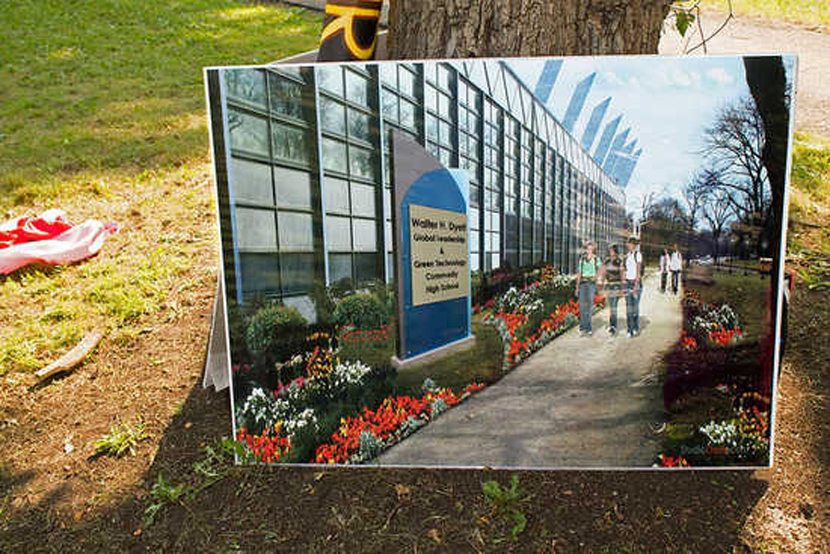
Artist’s conception of a future Dyett H.S. with solar panels on roof
It’s important to understand that the Coalition’s vision goes far beyond preparing students for the option of getting green jobs, as important as that is. There is also an all-encompassing philosophical or spiritual component that will go along with everything they plan to do, that the earth is our mother and human consciousness must be in harmony with that basic reality.
Young People As Global Leaders
'Why are they fighting us so hard about such a good plan? Why don’t they want our children to have a high quality school? Why don’t they want our children to succeed, to feel good about what they are doing in school?'
~ Dyett Hunger Striker Irene Robinson
Why indeed? Why on a planet undergoing terrifying climate change, and whose human population still suffers from the twin curses of poverty and violence, would the Mayor and Board of Education oppose a school based on green technology and global leadership?
The Coalition proposal speaks of young people entering the global stage as actors who have studied social and physical reality in depth. Of young people, people learning academic and artistic disciplines on behalf of environmental sustainability as well as peace and justice.
Does anyone seriously believe we can achieve environmental sustainability, peace and justice within the confines of our present badly broken racist social system? Either in the community of Bronzeville or in the world at large?
The system may be badly broken for most of us but it works well enough for the corporate elite which is who Mayor Emanuel and the Board of Education truly represent.
The Dyett proposal speaks of young people using their education to become global leaders, transforming their world and bettering the planet. This is education for liberation and is implicitly revolutionary in its implications. What if other communities began to demand such an education, an education that challenges a corrupt and brutal system of oppression? What then?
Perhaps this answers Irene Robinson’s question, ”Why are they fighting us so hard about such a good plan?”

Hunger striker Anna Jones at Operation PUSH
“For Further Reading
Walter Dyett High School for Global Leadership and Green Technology (the proposal submitted to the Chicago Board of Education)
The Dyett Hunger Strike website
Hunger Strike to Save Dyett High School in Bronzeville! by Teachers for Social Justice (blog with the latest Dyett updates.)
Phantoms Playing Double-Dutch: Why the Fight for Dyett is Bigger than One Chicago School Closing by Eve L. Ewing
Chicago Parents Enter Week 2 of Hunger Strike Protesting Corporate Ed Reform and Dyett HS Closure by Yana Kunichoff
A Proposal for Sustainable School Transformation by the Communities for Excellent Public Schools
Bob Simpson thinks of himself an old fashioned labor socialist. He believes this makes him “a genuine anachronism in our Brave New 21st Century.” With Estelle Carol he helps produce labor cartoons for the union movement.
This piece was reprinted by EmpathyEducates with permission or license. Grateful, we thank the Author, Bob Simpson for his kindness, quality observations, interviews and enduring efforts to bring equality to fruition. We also wish to extend our sincerest appreciation for the strength and wisdom that is the #WeAreDyett Coalition to Revitalize Dyett High School. Our thoughts are with the Hunger Strikers. Please America, ponder and speak out. Seek answers to the question, “Why don’t they want our children to have a high quality school?” #FightForDyett











Leave A Comment